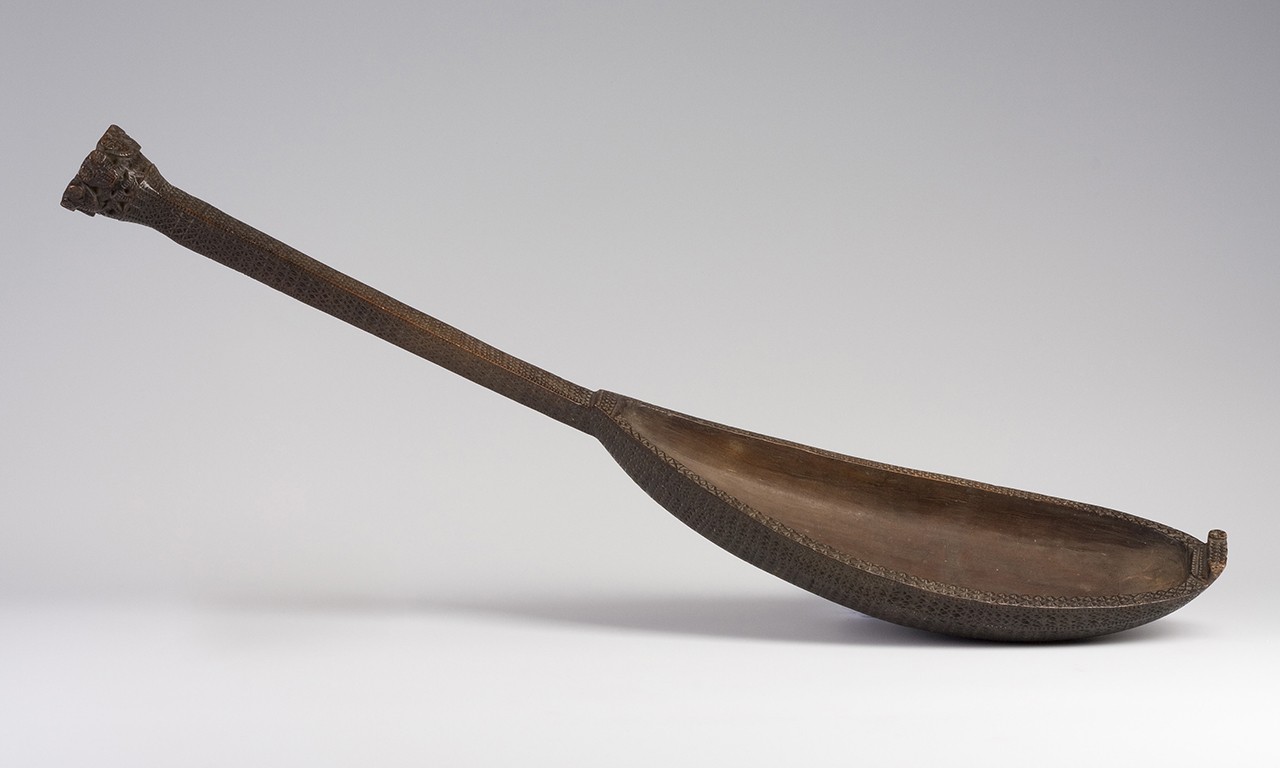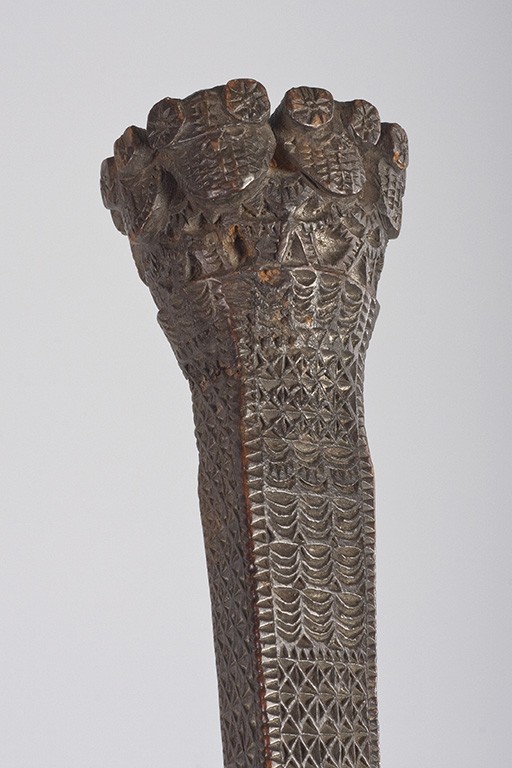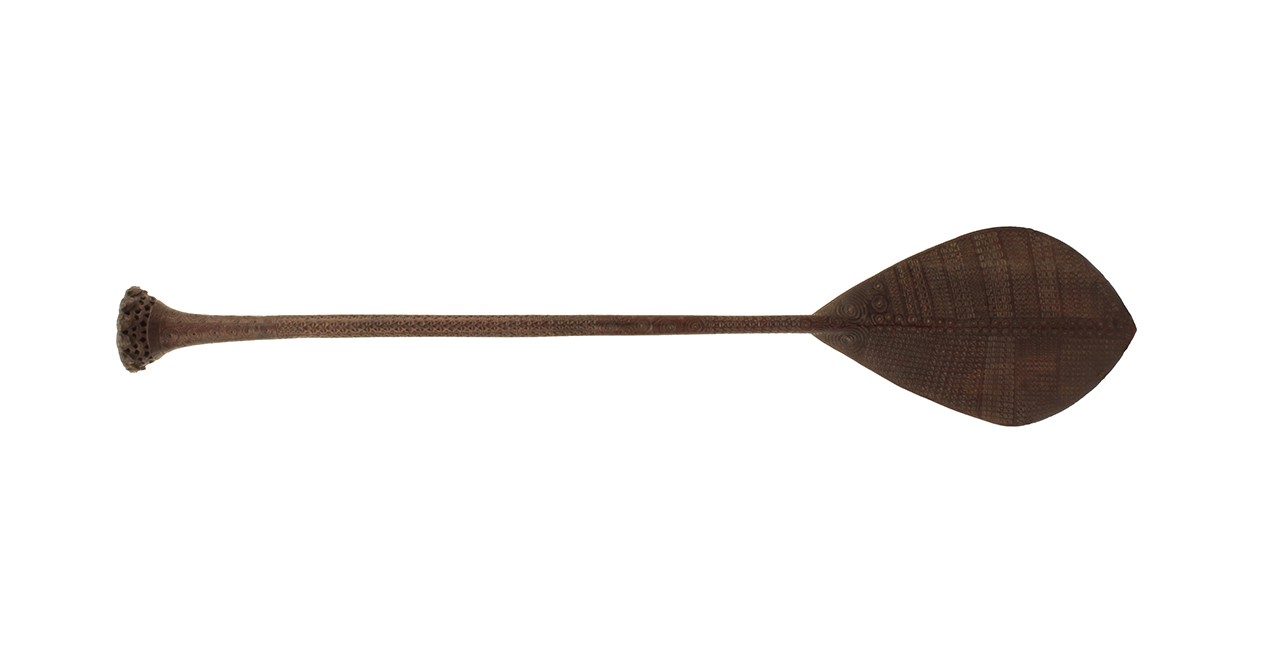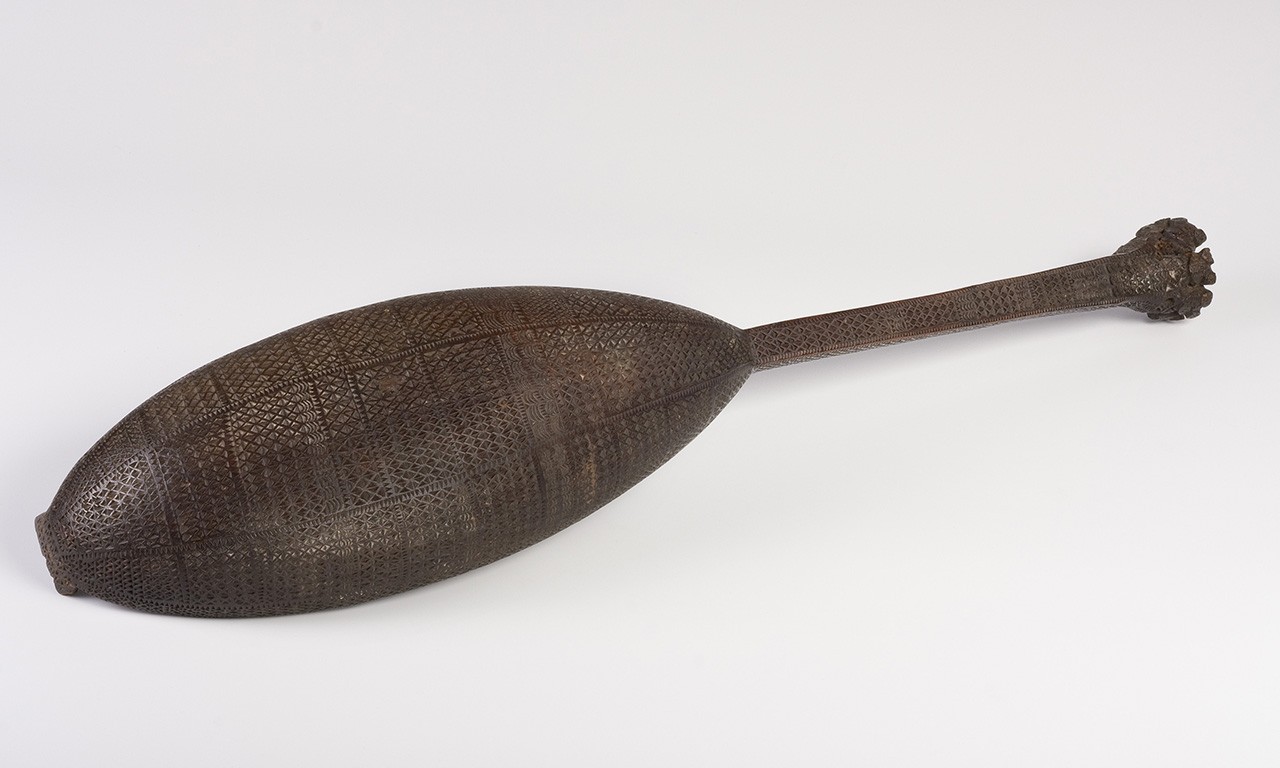 |
Ladle, early to mid 19th Century
Unrecorded artist; Raivavae or Tubuai, Austral Islands, French Polynesia, Polynesia
Wood; 28 7/8 x 5 3/4 x 4 1/2 in.
2006.7.2
Jordan Community Trust Purchase |
South Seas Islands
Situated in the southernmost region of French Polynesia, the five inhabited Austral Islands are famous for their distinctive wood carvings. Perhaps the two most distinctive carved object types to come from these islands are ornamental paddles and ceremonial ladles, which became fast favorites to 19th century Western collectors and quickly made their way around the world in incredibly high numbers. This post looks at a paddle and ladle in Bowers’ permanent collections from the Austral Islands and explores the history that brought them around the world and led to their prevalence in museum collections.
 |
| Raivavae From a French Government Survey, 1901. London Published at the Admiralty 19th Dec. 1904, under the Superintendence of Captain A. Mostyn Field, Hydrographer. |
Cooked Books
European explorers first reached the Austral Islands in the late 1700s but did not interact much with the Indigenous peoples there until the early years of the following century. James Cook led the first European crew to sight the islands and would have landed a party had a group of armed Rurutu warriors not intimidated him into continuing on his way. It was the Spanish naval officer Tomás Gayangos y Morquecho (1737-1796) that oversaw the first European landing in the Austral Islands on Raivavae in 1775, but in attempting to return with translators he too was rebuked by a group of war canoes. Successive waves of explorers, traders, and missionaries were ultimately successful in establishing footholds on the Austral Islands, but their legacy is one of death and cultural genocide. Somewhat rough estimates indicate that between 10,000 and 15,000 people were living on the five islands prior to European contact; by 1840 there were only 1,250 Indigenous people living on the islands.

 |
Detail of 2006.7.2
Jordan Community Trust Purchase |
Carving Frenzy
The years between 1820—the beginning of increasing European visitation to the Austral Islands and the population decline—and the 1840s—when the population decline finally evened out—were tumultuous for many reasons but it is likely that almost all decorated Austral Islands scoops and paddles found in museum collections were made during this period. As was the case anywhere that Europeans went, they carried deadly diseases that tore through antibody-less populations. As Austral Islanders died to plague and Christian missionaries proselytized, the number of individuals who subscribed to traditional beliefs dropped to almost zero. Woodcarvers had already been a small subset of the population but disappeared almost entirely as they were either pressured away from creating traditional carvings by missionaries or needed to assist with more basic professions. Though these object types assuredly predated the arrival of Europeans, there was no illustrated or eyewitness record of them being used before this period. There was already a great deal of trade between the Austral Islands and other French Polynesian island chains and little evidence of either the paddles or scoops seen there. It seems likely that as carvers were moving away from traditional beliefs they became aware of the increased demand for especially the paddles and began to produce them in incredibly high numbers. Within this same span of about 20 years, approximately 1,000 paddles were collected for museums and dealers. Surrounded on all sides by the death of loved ones and the disintegration of traditional values, these artists carved and carved, collectively creating an awe-inspiring body of work.

 |
Paddle, early to mid 19th Century
Unrecorded artist; Raivavae or Tubuai, Austral Islands, French Polynesia, Polynesia
Wood; 49 × 11 × 3 3/4 in.
2013.18.1
Bowers Museum Purchase |
Not Causing a Row
There are several factors that make paddles such as the Bowers’ example unique within the larger scope of Polynesian paddles. Firstly, it is intricately carved in low relief with interlocking asymmetrical motifs. These are overwhelmingly geometric: semi-circles, concentric circles, small notches, triangles, and zig-zagging lines; but the flared pommel is encircled with human figures. Despite being a paddle in name and overall form, the fragility of the decorated cylindrical shaft and the size of the leaf shaped head indicate that it was never used to propel a vessel. This paddle would have instead originally held some ceremonial or prestige function for the upper class. Based on the scarce provenance information of paddles in museum collections it appears that Raivavae and Tubuai were the only two islands where these paddles were carved—none come from Rurutu, Rapa, and Rimatara.
 |
Reverse of 2006.7.2
Jordan Community Trust Purchase |
The Scoop on Ladles
Much of the same holds true for this long-handled ladle. They are less common in collections, indicating that between 1821 and 1842 they were not produced in the same incredible quantities as the paddles. It is believed they were used to serve kava, an alcoholic drink made from kava root, though little else is known due to lack of surviving historical documentation. Rectilinear bands of repeating tiny diamond shapes give this scoop incredible texture. Experts have noted that even after metal tools were available to Austral Islands carvers, they continued to use shark tooth, shell, and stone tools as they were better-tailored to this type of detailed work.
Text and images may be under copyright. Please contact Collection Department for permission to use. Information subject to change upon further research.







Comments